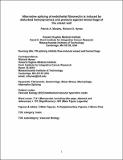| dc.contributor.author | Murphy, Patrick Andries | |
| dc.contributor.author | Hynes, Richard O | |
| dc.date.accessioned | 2015-08-19T12:01:26Z | |
| dc.date.available | 2015-08-19T12:01:26Z | |
| dc.date.issued | 2014-06 | |
| dc.date.submitted | 2014-01 | |
| dc.identifier.issn | 1079-5642 | |
| dc.identifier.issn | 1524-4636 | |
| dc.identifier.uri | http://hdl.handle.net/1721.1/98094 | |
| dc.description.abstract | Objective—Abnormally low-flow conditions, sensed by the arterial endothelium, promote aneurysm rupture. Fibronectin (FN) is among the most abundant extracellular matrix proteins and is strongly upregulated in human aneurysms, suggesting a possible role in disease progression. Altered FN splicing can result in the inclusion of EIIIA and EIIIB exons, generally not expressed in adult tissues. We sought to explore the regulation of FN and its splicing and their possible roles in the vascular response to disturbed flow.
Approach and Results—We induced low and reversing flow in mice by partial carotid ligation and assayed FN splicing in an endothelium-enriched intimal preparation. Inclusion of EIIIA and EIIIB was increased as early as 48 hours, with negligible increases in total FN expression. To test the function of EIIIA and EIIIB inclusion, we induced disturbed flow in EIIIAB[superscript −/−] mice unable to include these exons and found that they developed focal lesions with hemorrhage and hypertrophy of the vessel wall. Acute deletion of floxed FN caused similar defects in response to disturbed flow, consistent with a requirement for the upregulation of the spliced isoforms, rather than a developmental defect. Recruited macrophages promote FN splicing because their depletion by clodronate liposomes blocked the increase in endothelial EIIIA and EIIIB inclusion in the carotid model.
Conclusions—These results uncover a protective mechanism in the inflamed intima that develops under disturbed flow, by showing that splicing of FN mRNA in the endothelium, induced by macrophages, inhibits hemorrhage of the vessel wall. | en_US |
| dc.description.sponsorship | National Institutes of Health (U.S.) (Grant 5F32HL110484) | en_US |
| dc.description.sponsorship | National Institutes of Health (U.S.) (Grant PO1-HL66105) | en_US |
| dc.description.sponsorship | Howard Hughes Medical Institute | en_US |
| dc.description.sponsorship | National Cancer Institute (U.S.) (Koch Institute Support (Core) Grant P30-CA14051) | en_US |
| dc.language.iso | en_US | |
| dc.publisher | Ovid Technologies (Wolters Kluwer) -American Heart Association | en_US |
| dc.relation.isversionof | http://dx.doi.org/10.1161/atvbaha.114.303879 | en_US |
| dc.rights | Creative Commons Attribution-Noncommercial-Share Alike | en_US |
| dc.rights.uri | http://creativecommons.org/licenses/by-nc-sa/4.0/ | en_US |
| dc.source | Hynes | en_US |
| dc.title | Alternative Splicing of Endothelial Fibronectin Is Induced by Disturbed Hemodynamics and Protects Against Hemorrhage of the Vessel Wall | en_US |
| dc.type | Article | en_US |
| dc.identifier.citation | Murphy, P. A., and R. O. Hynes. “Alternative Splicing of Endothelial Fibronectin Is Induced by Disturbed Hemodynamics and Protects Against Hemorrhage of the Vessel Wall.” Arteriosclerosis, Thrombosis, and Vascular Biology 34, no. 9 (June 5, 2014): 2042–2050. | en_US |
| dc.contributor.department | Massachusetts Institute of Technology. Department of Biology | en_US |
| dc.contributor.department | Koch Institute for Integrative Cancer Research at MIT | en_US |
| dc.contributor.approver | Hynes, Richard O. | en_US |
| dc.contributor.mitauthor | Murphy, Patrick Andries | en_US |
| dc.contributor.mitauthor | Hynes, Richard O. | en_US |
| dc.relation.journal | Arteriosclerosis, Thrombosis, and Vascular Biology | en_US |
| dc.eprint.version | Author's final manuscript | en_US |
| dc.type.uri | http://purl.org/eprint/type/JournalArticle | en_US |
| eprint.status | http://purl.org/eprint/status/PeerReviewed | en_US |
| dspace.orderedauthors | Murphy, P. A.; Hynes, R. O. | en_US |
| dc.identifier.orcid | https://orcid.org/0000-0001-7603-8396 | |
| mit.license | OPEN_ACCESS_POLICY | en_US |
| mit.metadata.status | Complete | |
